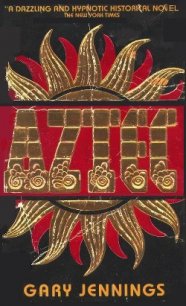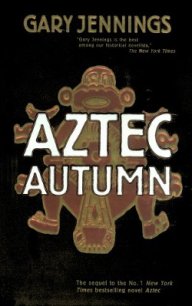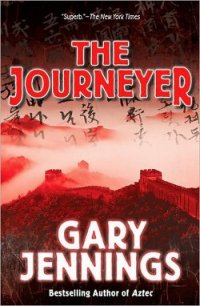Aztec Blood - Jennings Gary (книги онлайн бесплатно серия .txt) 📗
In pain and horror over his sin, Quetzalcoatl fled the golden city, setting sail upon the Eastern Sea with some of his followers on a raft made of intertwined snakes. Later he rose into the sky, becoming the Lord of the Dawn House, turning into the planet the Spaniards call Venus. He was a fiery eye in the sky, watching over the lands of the indios, waiting for the day when he would return to reclaim his kingdom. It was written that he would return in a One-Reed year.
For a decade before the arrival of the Spaniards, ominous signs had struck fear in the hearts of the indios as the One-Reed year approached—a fiery comet had appeared in the sky, earthquakes shook the land, and the mighty volcano Popocatepetl, the Smoking Mountain, had spit fire from the bowels of the underworld.
One of the most frightening events was a violent upheaval of the waters of Lake Texcoco, the lake that surrounds Tenochtitlan. Without warning or excessive rain, the waters of the lake suddenly swelled up as if lifted by a giant hand and overflowed into the island city, sweeping away many buildings.
Fire followed flood as one of the turrets of Tenochtitlan's great temple of Huitzilopochtli suddenly burst aflame without apparent cause and burned in defiance of all attempts to put it out.
Three comets were seen streaking across the night sky. Then, not long before the coming of the Spanish on the Eastern Sea, a strange golden light broke forth in the east. It glowed like a midnight sun, rising in the same pyramidal shape of an Aztec temple. The scribes recorded that fires burned so within it that it seemed "thickly powered with stars." Fray Antonio told me that it was the opinion of Church scholars that this event was a volcanic eruption, but some of the highest and most violent volcanoes in the world stood above the Valley of Mexico and one would think that the Aztecs would know the difference between volcanic eruption and heavenly fire.
At the same time of the golden pyramid of the night, low voices and doleful wailing was heard, as if to announce some strange, mysterious calamity.
Montezuma was terrified of the apparitions in the heavens and of his sister's death dream. When Cortes landed, a One-Reed year was coming around on the calendar wheel. Montezuma assumed that Quetzalcoatl had returned to claim his kingdom. Of course by now Quetzalcoatl's Tula was an abandoned city of ghostly stone temples, having been destroyed by invading barbarian armies, the Aztecs among them, hundreds of years before; but Montezuma thought he could pay tribute to Quetzalcoatl in goods and human hearts for the way the Aztecs had turned upon and devoured Tula.
Rather than driving the new arrivals into the sea with his overwhelming forces, gripped by fear and superstition, Montezuma sent an ambassador to salute Cortes and bring him gifts—while forbidding him to come to Tenochtitlan.
Among the gifts, Montezuma returned a Spanish helmet Cortes had sent to him. The helmet was overflowing with gold. There were also two great circular disks of gold and silver, as large as carriage wheels. The sight of golden gifts rather than force of arms did not pacify Cortes and his men; instead, it brought their greed to a boiling point.
But there was a great threat between them and the treasures of the Aztecs. The Spaniards realized that they were not dealing with a tribal chieftain but the monarch of a great nation, in size and population larger than most European countries. While the Spanish had superiority of weapons—the indio arrows and lances bounced off their armor—they were outnumbered a thousand to one. Any concerted attack by the Aztecs would succeed by sheer force of numbers.
The courage of his men wavered and Cortes, desperate that Velasquez would not get his prize, did the act of a man desperate for gold and glory—he burned his ships.
Now his men had only two choices—to fight or die. A handful of sailors and soldiers, around six hundred in all, found themselves stranded on the beach with their back to the water. To survive they had to defeat the army of an empire composed of millions of people.
One might fault Cortes on many levels. He was a womanizer, a slave master, a ruthless opponent, a man without respect for authority. But here was an act of daring and courage and brilliance that won a kingdom. To burn one's ships, to make him and his men cornered rats facing odds of a thousand to one, to have evaded the fate of an ordinary man, an ordinary leader who would have sent sail for reinforcements... this was the act of a muy hombre, very much man, worthy of Alexander the Great at Tyre, Julius Caesar at Munda, Hannibal crossing the Alps with elephants!
Another clever tactic was to work on the hatred the other indios had for the Aztecs to whom they paid tribute.
Using Dona Marina as his interpreter and mentor, Cortes convinced indio states that had been paying the Aztecs tribute in goods and sacrifice victims to ally themselves with him. The Aztec legions were dreaded much as the Roman legions and those of Genghis Khan, which had inspired fear into conquered people who were forced to pay tribute.
The strategy was successful. When Cortes marched upon Tenochtitlan, along with his men came indios numbering in the tens of thousands, the armies of Totonac, Tlaxcalans, and other nations anxious to use the Spanish to revenge countless aggressions by the domineering Aztecs.
Even with indio allies, the Aztecs were still the supreme fighting force in the New World. Without the quirk of fate that the indios believed that Cortes's arrival on the Eastern seashore fulfilled the Quetzalcoatl legend, Montezuma would have fielded an army that would have fallen upon the puny Spanish forces and its indio armies, sending the indios in terror from the dreaded Jaguar and Eagle Knights, who'd sworn to never retreat in battle. Montezuma's indecision cost him first his kingdom and then his life. He let the Spanish into his city without a fight.
One of the conquistadors, Bernal Diaz del Castillo, wrote a history of the conquest before my lifetime. A manuscript of it has circulated widely among the clerics of New Spain, and Fray Antonio had me read it so that I would learn the true story of how the Spanish had come to New Spain. Diaz's description of the city was the final fulfillment of the dream of Cortes and his men that he could find a fabled kingdom as had the hero of Amadis of Gaul. Diaz wrote that when the men saw Tenochtitlan for the first time, they realized that they had arrived at a golden city:
When we saw so many cities and villages built in the waters of the lake and other large towns on dry land, and that straight, level causeway leading into Mexico City, we were amazed and we said that it was like the enchanted things related in the book of Amadis because of the huge towers, temples, and buildings rising from the water and all of masonry. And some of the soldiers even asked whether the things we saw were not a dream.
After permitting the Spanish to enter his city, Montezuma, held prisoner in his palace by his "guests," tried to address his people. While many fell to the ground in awe of his august presence, some began to taunt him as a man who had been turned into a woman by the white men—that he was only fit to suckle babies and knead maize! Rocks and arrows loosened from the crowd and Montezuma fell.
He was as mortally wounded in soul as in body for the way his people turned on him. He knew he had failed them. The Spanish tried to treat his wounds but he tore off the bandages. He refused to survive his disgrace. Dying, he rejected baptism into the Christian faith, telling a priest kneeling at his side, "I have but a few moments to live and will not at this hour desert the faith of my fathers."
Catastrophic disasters erupted in the wake of the Spanish conquest. First came the destruction of the fabric of indio society as almost everything they had ever known and worshipped was trampled by the conquerors. It wasn't just stone edifices that were torn asunder, but the very fabric of society—just as birth and marriage and death revolve around a Christian Church, so was almost every aspect of the indio's life caught up in the priests and temples of their faith. Those temples were torn down and ones of the new faith erected, administered by priests who spoke a strange language.




